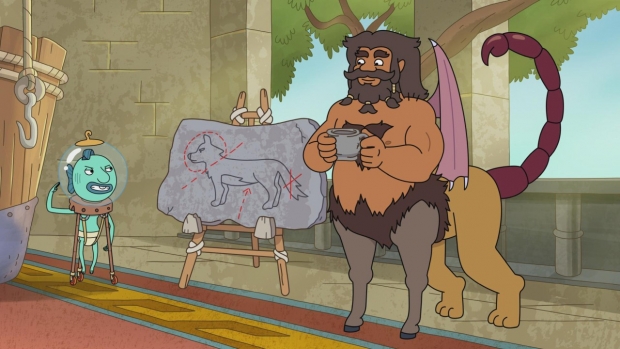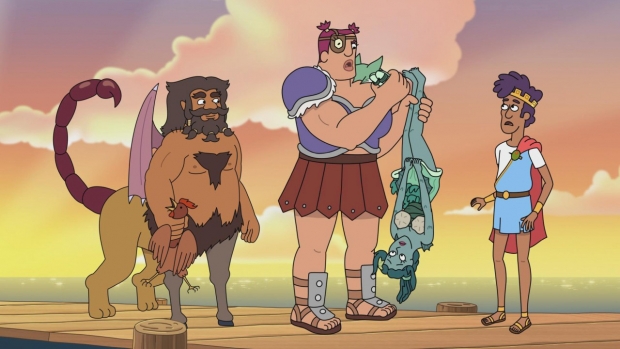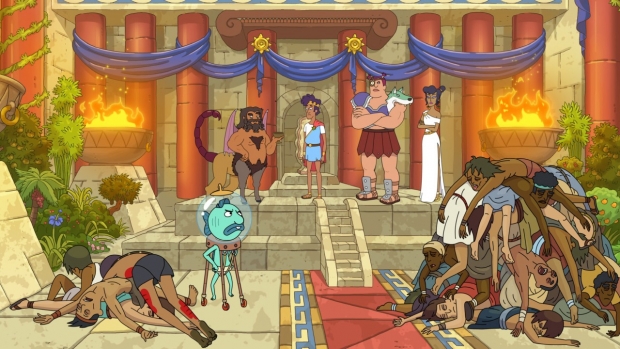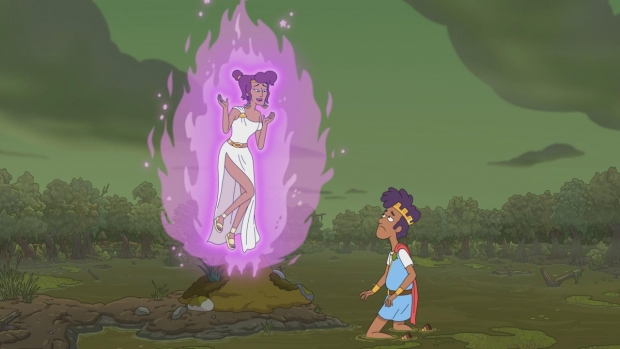For supervising director Pete Michels and lead character designer Andy Ristaino, there’s incredible joy, and challenge, in the production of all-new Dan Harmon and FOX 2D series’ abundant supply of weird creatures, from a mantitaur with five-animal-parts body to toothy krakens and seaweed-skinned princesses.
While most people find solace in reading fiction novels, Pete Michels gets his kicks from history and archeology books. So, when Dan Harmon, who Michels had worked with previously on Rick and Morty, reached out with a proposal for a parody series on Greek mythology, Michels jumped at the opportunity.
“I was like, ‘Oh, I get to draw all these gods and goddesses and monsters? Absolutely, yes,’” Michels remembers during an interview with AWN at the SCAD AnimationFest in Atlanta. “And the fact that it was about a family was an interesting twist.”
Krapopolis, which was renewed for a second and third season ahead of its September 24 series premiere on FOX, will air a new episode, "Prometheus,” this Sunday, October 8. The 2D series is set in mythical ancient Greece during the Bronze Age and tells the story of a dysfunctional family of humans, gods, and monsters that try their hand at running the world’s first cities – without trying to kill each other. Krapopolis features the voices of Emmy Award winner Hannah Waddingham (Ted Lasso), Richard Ayoade (The IT Crowd), Matt Berry (What We Do in The Shadows), Pam Murphy (Mapleworth Murders) and Duncan Trussell (The Midnight Gospel).
In the series, Ayoade voices Tyrannis, the mortal son of a goddess and benevolent King of Krapopolis, who tries to make do in a city that lives up to its name. Waddingham plays Deliria, Tyrannis’ mother, goddess of self-destruction and questionable choices. Deliria is as petty as she is powerful, and only seems interested in defending civilization if it means she’ll get more worshipers out of it than her frenemies up on Mt. Olympus. Berry is Shlub, Tyrannis’ father, a mantitaur (half centaur [horse + human], half manticore [lion + human + scorpion]). He’s the self-described “life of the orgy,” and a true pleasure seeker. Murphy voices Stupendous, Tyrannis’ half-sister, daughter of Deliria and a cyclops. Trussell plays Hippocampus, Tyrannis’ half-brother, offspring of Shlub and a mermaid, and a hot mess, biologically speaking.
The show, FOX’s first wholly-owned animated series, is produced by FOX’s Bento Box Entertainment. Harmon, who created the show, serves as Executive Producer. Michels serves as supervising director with Andy Ristaino as the lead character designer. At SCAD’s seventh annual AnimationFest, Michels and Ristaino premiered Episode 3, “Wife Swamp,” in an exclusive screening.
“Since I was a kid, I was always into Greek mythology,” says Ristaino, known for his character design work on Adventure Time. “And I’m a creature guy. So, I love any chance I get to design weird creatures.”
And there’s certainly no shortage of weird creatures on this series, from Shlub’s five-animal-parts body to toothy krakens and seaweed-skinned princesses. The five main characters on the series went through as many as 70 iterations.
“I love Stupendous,” says Ristaino of the eyepatch-wearing cyclops. “She might be my favorite character on the show. I just like her personality. She reminds me of my older brother, who was kind of a bully, but in an endearing way.”
Michels adds, “I can also identify with Hippocampus because I am the younger brother. And he’s one of my favorites to draw–next to Tyrannis–because he has such a wide range of expressions. He gets really emotional, really frustrated, and can get really angry and prone to loud yelling.”
Ristaino interjects, “He probably has the most cartoony look out of everyone. He has such a big face, so he can express a lot.”
The five main characters are made up, but they are surrounded by real figures in mythology, like Athena and Poseidon. Or, in the show’s case, “Broseidon.” Michels says that “putting modern personalities and an edge on these characters that we've heard about for thousands of years,” was an especially sweet part of the job and allowed him and Ristaino to take what the audience already expected from these legendary myths and undermine them in a way that would take even a well-read viewer by surprise.
“When you read the Greek myths, they are so out there,” notes Michels. “If you’d made this stuff up, and there wasn't Greek mythology already to back it up, you'd get laughed out of the office and told to come back with something more realistic. But that mythology exists, and it already is so weird that it automatically lends itself well to animation, and we can do all kinds of strange things with it and even expand on it in some really bizarre ways.”
In addition to consulting some of their writers with archeology degrees on the vegetables and fruits that would or would not be growing in the area, the team also had their own made-up rules to consider, such as figuring out the challenge of how a fish creature, whose head is stuck in a bowl, would eat dinner with the family and walk around on land–hence Hippocampus’ walker.
Michels and Ristaino also had the added challenge of solving the puzzle of their character transformations. Deliria, along with being Goddess of Self-Destruction and Questionable Choice, is a shapeshifter and can transform herself into any animal.
“Story-wise, it made sense for the transforming to be as quick as possible, because there are a lot of transformations in the show,” notes Ristaino. “It's not like that episode of Rick and Morty where Morty turns into a car as a way to poke fun at Turbo Teen. That’s like a one-minute transformation. We didn’t want to take that much time on the transformations in this show because it stops the next joke from happening.”
“And it would put the brakes on the pacing of the story,” adds Michels. “We’re also making sure that the mid-pose transformation color pallet is a good transition between things like Deliria’s regular form and the shark or ostrich or whatever it is she transforms into. Sometimes it’s a decent amount of color switches.”
As carefully as they checked the speed and coloring of the characters' transformations, Ristaino and Michels were very comfortable with the animators making the mid-transformation poses and facial expressions as dramatic and unnerving as they’d like, unafraid of those viewers who may try to pause at just the right frame to catch an awkward moment.
“It’s a cartoon,” says Ristaino. “It can be as weird as we want it to be. Outside of our guideline to keep things fast, the animators ultimately had free reign.”
Deliria can not only transform herself into the creature of her choosing, but her human subjects as well. In a fit of rage and competition with her nemesis Athena, Deliria loses her cool and morphs the citizens of Krapopolis into snakes. Of course, she transforms each one back, but the incident is not without side effects.
“We had a rule that if Deliria turns a human into an animal, they’re going to be naked if they transform back, which creates its own set of challenges, like staging and placement issues,” says Michels. “We can’t even show butts. We had more notes on nudity than even the blood and gore that’s in the show.”
The large group transformations required Michels and Ristaino to also reconsider their approach to some of the animation.
“The first season we were using Harmony to do the animation, but in a traditional hand-drawn way,” explains Michels. “But as the show's grown, the character numbers have grown and one of the biggest challenges is that we have a lot of crowds and battles. To help alleviate some of the time, we did some 3D builds on some of those characters. And, moving forward, we will be using more rigged animation. Our challenge then will be to make it still look hand-drawn. We’ll see how it goes.”
Krapopolis’ second and third seasons are currently in production and, according to Risaino, viewers can expect to see a lot more gods and goddesses; as many as 120, with some being new creations and others being familiar favorites like Hydras and Pegasus.
“And Andy’s designed both of us to be gods as well,” says Michels. “So, yeah, we’re going to be gods. No big deal.”
Whether or not Michels’ declaration is a red herring or not will be up to fans to discover for themselves as they await the release of the next seasons of Krapopolis. Dates have yet to be announced.













